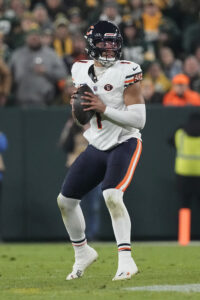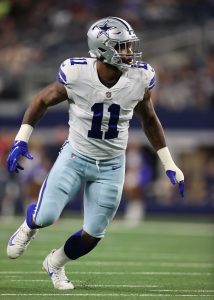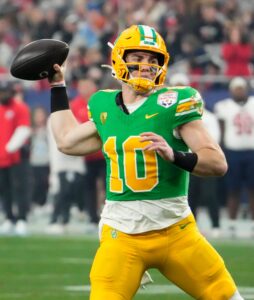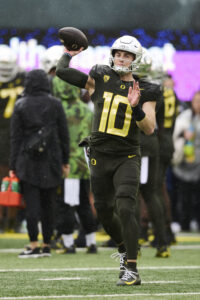Bailing on their handpicked Ben Roethlisberger successor two years in, the Steelers put together one of the more interesting quarterback offseasons in recent NFL history. Two starters on other teams last season are now in the mix, with neither tied to a pricey deal nor a commitment beyond 2024.
The dominoes that led Kenny Pickett out of Pittsburgh began to fall before the team’s Russell Wilson signing, but that contract — a veteran-minimum deal agreed to before the Broncos officially designated Wilson a post-June 1 cut — led the way in driving Pickett to Philadelphia. After it looked like Wilson had a firm grip on the Steelers’ starting job, the team reached an agreement on a low-cost trade for Justin Fields. The final year of the ex-Bears first-rounder’s rookie contract is on the Steelers’ payroll — at the cost of merely a conditional sixth-round pick.
 Mike Tomlin has said plenty to suggest Wilson will be his starter in 2024, but given the age gap between the two high-profile acquisitions and how the potential Hall of Famer’s Denver chapter unfolded, it would be a bit unusual if Fields was not mentioned as a candidate to step in at some point. The team has already been linked to pursuing potential deals with both QBs beyond 2024, though the club’s longstanding policy not to negotiate contracts in-season will put these efforts on hold. That seems unrealistic, given each’s starter background. For this year, however, the Steelers have assembled a unique depth chart — one that also includes UFA addition Kyle Allen.
Mike Tomlin has said plenty to suggest Wilson will be his starter in 2024, but given the age gap between the two high-profile acquisitions and how the potential Hall of Famer’s Denver chapter unfolded, it would be a bit unusual if Fields was not mentioned as a candidate to step in at some point. The team has already been linked to pursuing potential deals with both QBs beyond 2024, though the club’s longstanding policy not to negotiate contracts in-season will put these efforts on hold. That seems unrealistic, given each’s starter background. For this year, however, the Steelers have assembled a unique depth chart — one that also includes UFA addition Kyle Allen.
An eight-asset package — headlined by two first-round picks — brought Wilson to Denver. The Broncos cut the cord on the Wilson contract before the extension years (on a five-year, $245MM deal) began. This will bring record-smashing dead money to Denver’s payroll, as the Steelers’ Wilson contract (one year, $1.2MM) barely ate into the $85MM dead cap coming the Broncos’ way through 2025. Wilson bounced back in 2023, but Sean Payton deeming him a bad fit represented another setback in a career that has veered off course.
After a shockingly poor 2022 season when paired with overmatched HC Nathaniel Hackett, Wilson rebounded — to a degree — under Payton by throwing 26 touchdown passes compared to eight interceptions. Slotting him 12 points higher than 2022, QBR ranked Wilson 21st last season. That settled in six spots behind Fields. It is arguable Wilson (six original-ballot Pro Bowl nods) disrupted his Hall of Fame path with the Broncos stay and needs a strong Steelers season to firmly reestablish himself as a Canton-bound player. Fields stands in the way of this reality, and Tomlin kept the door open — while still affirming Wilson will go into training camp as the starter — for the younger player to challenge for the job at some point.
While Wilson trails only Michael Vick and Cam Newton in career QB rushing yards and is the league’s only 40,000-5,000 player, Fields is certainly a better runner from the position. Joining Wilson with a propensity to take sacks, Fields both led the NFL in sacks taken and QB rushing yards in 2022. The Bears saw some improvement through the air last season, and QBR interestingly viewed the Ohio State product’s 2022 showing as superior to his 2023 slate. Fields also posted a worse yards-per-attempt number (6.9) compared to 2022 (7.1) and upped his passer rating by barely a point from the ’22 campaign.
 Mentioned as a player expected to command at least a Day 2 pick in a trade, Fields bringing the trade value he did reflects a dim outlook around the league regarding his potential to improve significantly as a passer. The Steelers quickly declined Fields’ fifth-year option, joining the Broncos (Zach Wilson), Cowboys (Trey Lance) and Jaguars (Mac Jones) in passing on an extra year for a recently acquired QB. Pittsburgh will still attempt to finetune the former No. 11 overall pick, and it will be interesting to see how long they do so while keeping him in a backup role. If Fields plays at least 51% of Pittsburgh’s offensive snaps this season, the 2025 pick owed to the Bears vaults to a fourth-rounder.
Mentioned as a player expected to command at least a Day 2 pick in a trade, Fields bringing the trade value he did reflects a dim outlook around the league regarding his potential to improve significantly as a passer. The Steelers quickly declined Fields’ fifth-year option, joining the Broncos (Zach Wilson), Cowboys (Trey Lance) and Jaguars (Mac Jones) in passing on an extra year for a recently acquired QB. Pittsburgh will still attempt to finetune the former No. 11 overall pick, and it will be interesting to see how long they do so while keeping him in a backup role. If Fields plays at least 51% of Pittsburgh’s offensive snaps this season, the 2025 pick owed to the Bears vaults to a fourth-rounder.
The post-Killer B’s Steelers have been among the NFL’s most dependable teams, but the ceiling from the Roethlisberger-Antonio Brown–Le’Veon Bell period dropped as Big Ben aged and then Pickett, Mitch Trubisky and Mason Rudolph stepped in. Improved Pittsburgh defenses have been unable to make the past three Steelers squads, even as two of them advanced to the postseason, Super Bowl-caliber operations. This season will be key to isolate some variables within the organization, as Pickett and since-booted OC Matt Canada are gone. After seeing QB play sink his Falcons tenure, OC Arthur Smith will be tasked with coaching two middling — at this point, at least — signal-callers.
The Steelers are banking that Smith and the Wilson-Fields duo will provide sufficient upgrades from their previous play-calling setup and what the QB group of the past two seasons offered. Who will be the quarterback that ends up as the team’s preferred option by the season’s stretch run? Who gives the Steelers the best chance to succeed? Vote in PFR’s latest poll and weigh in with your thoughts on this revamped setup in the comments section.



